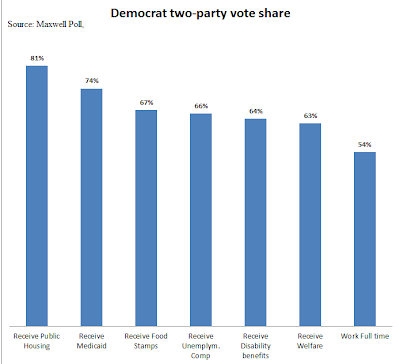Paul Krugman is in puzzlement, having observed that Red States get more welfare funding, while Republican voters oppose the welfare state. He portrays Republicans as “Moochers” who are either hypocritical or too stupid to know their own best interest.
But as we know, states do not vote, individuals do. There is only a paradox if Republican voters receive welfare at above average rates while voting against it. From the Gellman-paradox we know that the low-income voters who drag down the Red States average tend to vote disproportionally for Democrats. Republican voters earn significantly more than Democrats, even though Red state earn less than Blue states.
Krugman reports no individual level data, so let me. The Maxwell Poll has detailed information about welfare use. The data is from 2004-2007. During this period in these polls a plurality of voters supported Democrats. I will graph the two-party vote, more data is at the end.

Hardly surprising, we see that in a two-party split, 60-80% of welfare recipients are Democrats, while full time Workers are evenly divided between parties.
You have similar results in this recent NPR-Poll. Among the Long Term Unemployed, 72% of the two-party support goes to Democrats.
It appears that once more common sense is right and the impression left by the New York Times wrong. Indeed, people who live off the government disproportionally support Democrats.
Given that Krugman is aware of the Gellman-Paradox, he should have reported the individual level data first instead of wasting everyone’s time with state-level aggregation that we already know is wrong. Instead he acknowledged that state level data is probably wrong (to get cover), then goes ahead and relies on the wrong method anyway, since it produces the results he wants. The false impression that Republicans use more welfare is already spread around the internet by liberals who still trust Krugman.
Appendix:
Share of Recipients of each program that self-identified as supporters of Republican party in 2004-2007 Maxwell Poll:
Gov. Subsidized Housing 12%
Medicaid: 16%
Food Stamps: 20%
Unemployment Compensation: 21%
Welfare or public assistance: 22%
Disability benefits from government 25%
But as we know, states do not vote, individuals do. There is only a paradox if Republican voters receive welfare at above average rates while voting against it. From the Gellman-paradox we know that the low-income voters who drag down the Red States average tend to vote disproportionally for Democrats. Republican voters earn significantly more than Democrats, even though Red state earn less than Blue states.
Krugman reports no individual level data, so let me. The Maxwell Poll has detailed information about welfare use. The data is from 2004-2007. During this period in these polls a plurality of voters supported Democrats. I will graph the two-party vote, more data is at the end.

Hardly surprising, we see that in a two-party split, 60-80% of welfare recipients are Democrats, while full time Workers are evenly divided between parties.
You have similar results in this recent NPR-Poll. Among the Long Term Unemployed, 72% of the two-party support goes to Democrats.
It appears that once more common sense is right and the impression left by the New York Times wrong. Indeed, people who live off the government disproportionally support Democrats.
Given that Krugman is aware of the Gellman-Paradox, he should have reported the individual level data first instead of wasting everyone’s time with state-level aggregation that we already know is wrong. Instead he acknowledged that state level data is probably wrong (to get cover), then goes ahead and relies on the wrong method anyway, since it produces the results he wants. The false impression that Republicans use more welfare is already spread around the internet by liberals who still trust Krugman.
Appendix:
Share of Recipients of each program that self-identified as supporters of Republican party in 2004-2007 Maxwell Poll:
Gov. Subsidized Housing 12%
Medicaid: 16%
Food Stamps: 20%
Unemployment Compensation: 21%
Welfare or public assistance: 22%
Disability benefits from government 25%






